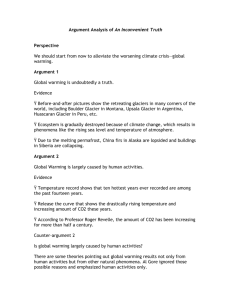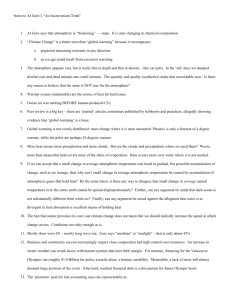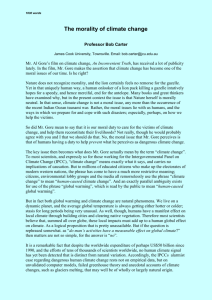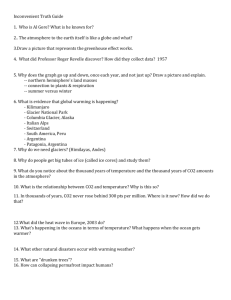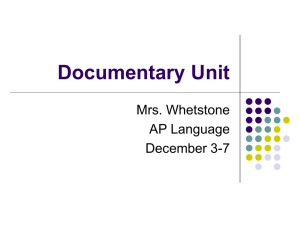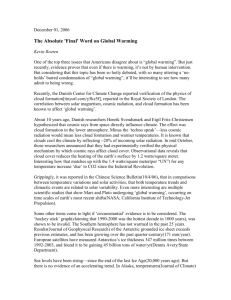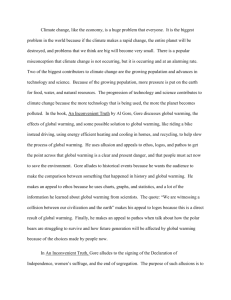2 - Friends of Science
advertisement
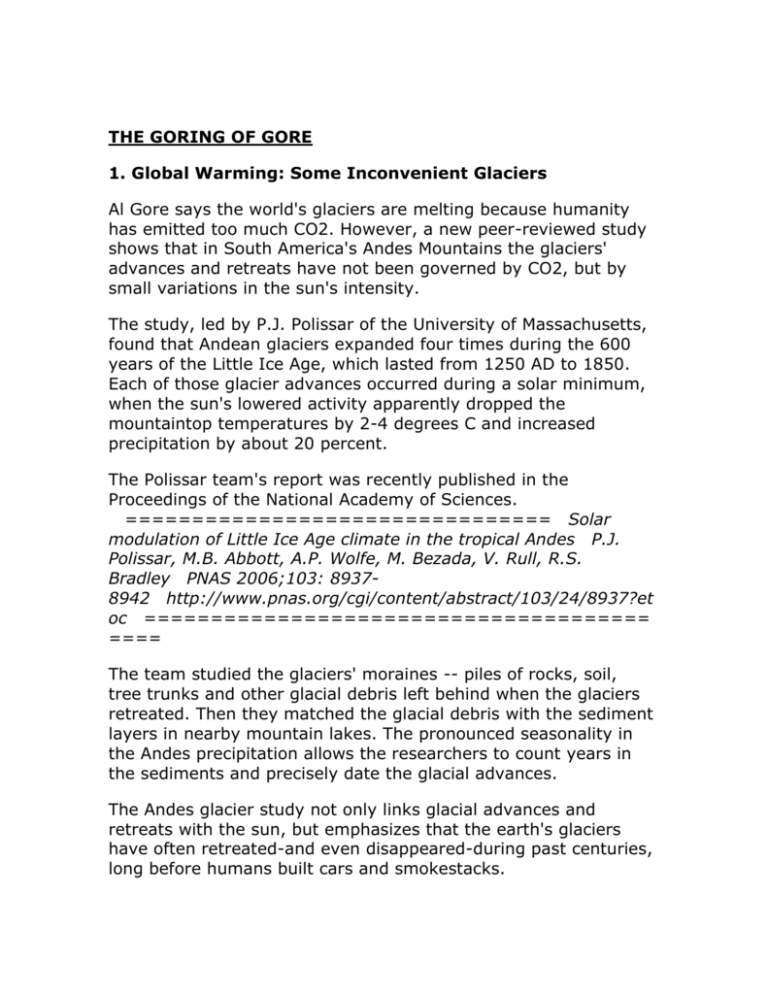
THE GORING OF GORE 1. Global Warming: Some Inconvenient Glaciers Al Gore says the world's glaciers are melting because humanity has emitted too much CO2. However, a new peer-reviewed study shows that in South America's Andes Mountains the glaciers' advances and retreats have not been governed by CO2, but by small variations in the sun's intensity. The study, led by P.J. Polissar of the University of Massachusetts, found that Andean glaciers expanded four times during the 600 years of the Little Ice Age, which lasted from 1250 AD to 1850. Each of those glacier advances occurred during a solar minimum, when the sun's lowered activity apparently dropped the mountaintop temperatures by 2-4 degrees C and increased precipitation by about 20 percent. The Polissar team's report was recently published in the Proceedings of the National Academy of Sciences. ================================ Solar modulation of Little Ice Age climate in the tropical Andes P.J. Polissar, M.B. Abbott, A.P. Wolfe, M. Bezada, V. Rull, R.S. Bradley PNAS 2006;103: 89378942 http://www.pnas.org/cgi/content/abstract/103/24/8937?et oc ====================================== ==== The team studied the glaciers' moraines -- piles of rocks, soil, tree trunks and other glacial debris left behind when the glaciers retreated. Then they matched the glacial debris with the sediment layers in nearby mountain lakes. The pronounced seasonality in the Andes precipitation allows the researchers to count years in the sediments and precisely date the glacial advances. The Andes glacier study not only links glacial advances and retreats with the sun, but emphasizes that the earth's glaciers have often retreated-and even disappeared-during past centuries, long before humans built cars and smokestacks. Most of the Andes glaciers must have disappeared during the Holocene Warming that ended just 5,000 years ago. Temperatures then were as much as 2 degrees C warmer than today's. So far, the Modern Warming has produced about only 0.8 degrees C of total temperature rise in its 150 years. The sun has been linked to earth's climate changes for the past 400 years-by sunspot records. Early astronomers noted that the two coldest periods of the Little Ice Age occurred when there were virtually no sunspots on the sun. The Sporer Minimum lasted from 1420 to 1570, and the Maunder Minimum from 1645 to 1710. The solar-earth linkage came to the fore again in the 1980s, when researchers brought up the first long ice cores from Greenland and the Antarctic. The 400,000 years of temperature history contained in the ice cores clearly showed a moderate, natural cycle that raised temperatures at the latitude of New York and Paris by about 2 degrees C, and then lowered them by a similar amount. The cycles averaged about 1500 years in length. Carbon14 and beryllium-10 isotopes in the ice clearly linked this temperature cycle to the sun. The question for Al Gore is not whether our temperatures are rising; the key question is why are they rising? Antarctic ice cores tell us that temperatures and CO2 in the atmosphere have tracked closely together through recent Ice Ages, but the CO2 changes have lagged behind the temperature changes by about 800 years. Higher temperatures have produced more atmospheric CO2, rather than CO2 producing higher temperatures! That's because most of the planet's CO2 is stored in the oceans, and as the seawater warms, it can't hold as much CO2. If CO2 is the driving climate force, why did the earth begin warming in 1850, while human CO2 emissions didn't start to really expand until about 1940? Mr. Gore doesn't tell us the answer. Why did the earth's temperatures decline from 1940 to 1975, even as CO2 emissions were soaring? Mr. Gore doesn't say. How warm will New York get in the Modern Warming? Apparently Mr. Gore can't tell us, but a total of 2 degrees C seems likely -based on the history in the ice cores. ================================= Dennis Avery is a fellow of the Hudson Institute and co-author (with S. Fred Singer) of the forthcoming book "Unstoppable Global Warming - Every 1500 Years" Rowland and Littlefield Publ., Lanham, Md, 2006 ****************************** 2. "An Inconvenient Truth" by Debra J. Saunders San Francisco Chronicle, 13 June 2006 http://www.sfgate.com/cgibin/article.cgi?file=/c/a/2006/06/13/EDGDOILMDO1.DTL THERE IS A CONCEIT among the American Left that the American Right cleaves to bad science out of deference to religion, while the left is all-science all-the-time. Former Veep Al Gore's new movie, "An Inconvenient Truth," however, shows how unscientific -- and downright faith-based -- the left has become. Is global warming human-induced? Gore says that it is, and he may well be right. Last month in the New York Times, Gregg Easterbrook of the Brookings Institution announced that he had converted from global-warming "skeptic to convert." Easterbrook noted that a 1992 survey found that a mere 17 percent of members of the American Geophysical Union and American Meteorological Society believed in greenhouse-gas climate change. Since then, scientists have found more evidence of the phenomenon. Gore was wrong in 1992 when he wrote that 98 percent of scientists agreed with him on global warming. Witness the survey cited above. Now he is wrong when he argues in his movie that there is a complete consensus on global warming today. As proof Gore cites a 2004 study that looked at 928 climate abstracts and found none that refuted global-warming dogma. That says more about the researcher than the scientific community. There are a number of well-known scientists who don't believe that global warming is human-induced, or who believe that if it is, it is not catastrophic. Hurricane expert William Gray of Colorado State University believes the Earth will start to cool within 10 years. Neil Frank, former director of the National Hurricane Center, told the Washington Post that global warming is "a hoax." Climate scientist Robert Lindzen of MIT believes that clouds and water vapor will counteract greenhouse-gas emissions. So you have to ask yourself: Why does Gore pretend that apostates do not exist? Scientists acknowledge contradictory data. But the faith-driven Gore argues that all scientists agree with him -- well, except for those who are bought and paid for by big polluters. Because this is a crusade -- and not about science -- Gore is drawn, not to the most reasoned scenarios, but the most apocalyptic. Consider this exchange with ABC's George Stephanopoulos -formerly of the Clinton/Gore administration -- who questioned Gore's prediction that global-warming could cause sea levels to rise 20 feet. "But the consensus is several inches over the next century. Right?" asked Stephanopoulos on June 4. "Not 20 feet?" "Not at all," Gore replied. He added that the scientists he talks to -- his disciples, if you will -- see it his way. He ignores the less catastrophic theories, which predict a rise of an inch per decade, or up to ten inches over the next century. To Gore, the worstcase scenario is the only scenario. I thought Gore's chart comparing carbon-dioxide increases to temperature spikes was dramatic. But because Gore omits what he does not want to see, I have to listen to former NASA scientist, Roy Spencer of the University of Alabama, when he tells me, "It is an alarming chart, but there are so many alternative explanations for what he's showing. He's giving it one possible explanation and making it sound like the only explanation." Spencer says it is "more likely" that the higher temperatures increased carbon-dioxide levels. Spencer, who also writes for TCS Daily (which receives some funding from ExxonMobil), believes that some global warming is human-induced, but "I don't believe in climate catastrophe. And: "It comes down to whether you believe the climate system is fragile or resilient." So it all comes down to belief -- and that is the problem. Global warming has become so politicized that scientists must believe in it. If they predict dire consequences, they win praise from true believers and grants for their important research. Scientists who question the prophecies of doom can expect to be marginalized. Oddly, Gore begins "An Inconvenient Truth" discussing a young classmate who wondered if South America and Africa once had been connected. Their teacher ridiculed the friend, who turned out to be right. Sometimes the know-it-alls are wrong. Now Gore is the know-it-all teacher -- and woe to any scientist who does not agree with him, not just on global warming, but also on a 20-foot rise in sea level. It is this alarmism -- this extremism -- that has led many a thinking person to question global warming. It's hard to trust those who believe only the most extreme scenario. Besides, whenever the establishment says you have to believe something, you want people who question the establishment. Or as global cooling guru Gray once said, "Consensus science isn't science." ******************************** 3. Scientists respond to Gore's warnings of climate catastrophe: " Inconvenient Truth" is indeed inconvenient to alarmists By Tom Harris Monday, June 12, 2006 "Scientists have an independent obligation to respect and present the truth as they see it," Al Gore sensibly asserts in his film "An Inconvenient Truth", showing in Toronto since Jun 2. With that outlook in mind, what do world climate experts actually think about the science of his movie? Professor Bob Carter of the Marine Geophysical Laboratory at James Cook University, in Australia gives what, for many Canadians, is a surprising assessment: "Gore's circumstantial arguments are so weak that they are pathetic. It is simply incredible that they, and his film, are commanding public attention." But surely Carter is merely part of what most people regard as a tiny cadre of "climate change skeptics" who disagree with the "vast majority of scientists" Gore cites? No; Carter is one of hundreds of highly qualified nongovernmental, non-industry, non-lobby-group climate experts who contest the hypothesis that human emissions of carbon dioxide (CO2) are causing significant global climate change. "Climate experts" is the operative term here. Why? Because what Gore's "majority of scientists" think is immaterial when only a very small fraction of them actually work in the climate field. Even among that fraction, many focus their studies on the impacts of climate change; biologists, for example, who study everything from insects to polar bears to poison ivy. "While many are highly skilled researchers, they generally do not have special knowledge about the causes of global climate change," explains former University of Winnipeg climatology professor Dr. Tim Ball. "They usually can tell us only about the effects of changes in the local environment where they conduct their studies." This is highly valuable knowledge, but doesn't make them climate-change-cause experts, only climate-impact experts. So we have a smaller fraction. But it becomes smaller still. Among experts who actually examine the causes of change on a global scale, many concentrate their research on designing and enhancing computer models of hypothetical futures. "These models have been consistently wrong in all their scenarios," asserts Ball. "Since modelers concede computer outputs are not "predictions" but are in fact merely scenarios, they are negligent in letting policy-makers and the public think they are actually making forecasts." We should listen most to scientists who use real data to try to understand what nature is actually telling us about the causes and extent of global climate change. In this relatively small community, there is no consensus, despite what Gore and others would suggest. Here is a small sample of the side of the debate we almost never hear: Appearing before the Commons Committee on Environment and Sustainable Development last year, Carleton University paleoclimatologist Professor Tim Patterson testified, "There is no meaningful correlation between CO2 levels and Earth's temperature over this [geologic] time frame. In fact, when CO2 levels were over ten times higher than they are now, about 450 million years ago, the planet was in the depths of the absolute coldest period in the last half billion years." Patterson asked the committee, "On the basis of this evidence, how could anyone still believe that the recent relatively small increase in CO2 levels would be the major cause of the past century's modest warming?" Patterson concluded his testimony by explaining what his research and "hundreds of other studies" reveal: On all time scales, there is very good correlation between Earth's temperature and natural phenomena such changes in the brightness of the Sun. Dr. Boris Winterhalter, former marine researcher at the Geological Survey of Finland and professor in marine geology, University of Helsinki, takes apart Gore's dramatic display of Antarctic glaciers collapsing into the sea. "The breaking glacier wall is a normally occurring phenomenon, which is due to the normal advance of a glacier," says Winterhalter. "In Antarctica the temperature is low enough to prohibit melting of the ice front, so if the ice is grounded, it has to break off in beautiful ice cascades. If the water is deep enough icebergs will form." Dr. Wibjörn Karlén, emeritus professor, Dept. of Physical Geography and Quaternary Geology, Stockholm University, Sweden, admits, "Some small areas in the Antarctic Peninsula have broken up recently, just like it has done back in time. The temperature in this part of Antarctica has increased recently, probably because of a small change in the position of the low pressure systems." But Karlén clarifies that the 'mass balance' of Antarctica is positive - more snow is accumulating than melting off. As a result, Ball explains, there is an increase in the 'calving' of icebergs as the ice dome of Antarctica is growing and flowing to the oceans. When Greenland and Antarctica are assessed together, "their mass balance is considered to possibly increase the sea level by 0.03 mm/year - not much of an effect," Karlén concludes. Antarctica has survived warm and cold events over millions of years. A meltdown is simply not a realistic scenario in the foreseeable future. Gore tells us in the film, "Starting in 1970, there was a precipitous drop-off in the amount and extent and thickness of the Arctic ice cap." This is misleading, according to Ball: "The survey that Gore cites was a single transect across one part of the Arctic basin in the month of October during the 1960s when we were in the middle of the cooling period. The 1990 runs were done in the warmer month of September, using a wholly different technology." Karlén explains that a paper published in 2003 by University of Alaska professor Igor Polyakov shows that, the region of the Arctic where rising temperature is supposedly endangering polar bears showed fluctuations since 1940 but no overall temperature rise. "For several published records it is a decrease for the last 50 years," says Karlén Dr. Dick Morgan, former advisor to the World Meteorological Organization and climatology researcher at University of Exeter, U.K. gives the details, "There has been some decrease in ice thickness in the Canadian Arctic over the past 30 years but no melt down. The Canadian Ice Service records show that from 1971-1981 there was average, to above average, ice thickness. From 1981-1982 there was a sharp decrease of 15% but there was a quick recovery to average, to slightly above average, values from 1983-1995. A sharp drop of 30% occurred again 1996-1998, and since then there has been a steady increase to reach near normal conditions since 2001." Concerning Gore's beliefs about worldwide warming, Morgan points out that, in addition to the cooling in the NW Atlantic, massive areas of cooling are found in the North and South Pacific Ocean; the whole of the Amazon Valley; the north coast of South America and the Caribbean; the eastern Mediterranean, Black Sea, Caucasus and Red Sea; New Zealand and even the Ganges Valley in India. Gore's point that 200 cities and towns in the American West set all-time high temperature records is also misleading, according to Dr. Roy Spencer, Principal Research Scientist at The University of Alabama in Huntsville. "It is not unusual for some locations, out of the thousands of cities and towns in the U.S., to set all-time records," he says. "The actual data shows that overall, recent temperatures in the U.S. were not unusual." Carter does not pull his punches about Gore's activism, "The man is an embarrassment to US science and its many fine practitioners, a lot of whom know (but feel unable to state publicly) that his propaganda crusade is mostly based on junk science." In April, sixty of the world's leading experts in the field asked Prime Minister Harper to order a thorough public review of the science of climate change, something that has never happened in Canada. Considering what's at stake -- either the end of civilization, if you believe Gore, or a waste of billions of dollars, if you believe his opponents -- it seems like a reasonable request. ====================================== * Tom Harris is mechanical engineer and Ottawa Director of High Park Group, a public affairs and public policy company. *************************** 4. The gods are laughing Scientists (who work in the fields that liberal arts graduate Al Gore wanders through) contradict his theories about man-induced climate change Tom Harris National Post, June 7, 2006 Albert Einstein once said, "Whoever undertakes to set himself up as a judge of truth and knowledge is shipwrecked by the laughter of the gods." While the gods must consider An Inconvenient Truth the ultimate comedy, real climate scientists are crying over Al Gore's new film. This is not just because the ex-vice-president commits numerous basic science mistakes. They are also concerned that many in the media and public will fail to realize that this film amounts to little more than science fiction. Gore's credibility is damaged early in the film when he tells the audience that, by simply looking at Antarctic ice cores with the naked eye, one can see when the US Clean Air Act was passed. Dr. Ian Clark, professor of Earth Sciences at the University of Ottawa, responds, "This is pure fantasy unless the reporter is able to detect parts per billion changes to chemicals in ice." Air over the United States doesn't even circulate to the Antarctic before mixing with most of the northern, then the southern, hemisphere air, and this process takes decades. Clark explains that even far more significant events, such as the settling of dust arising from the scouring of continental shelves at the end of ice ages, are undetectable in ice cores by an untrained eye. Gore repeatedly labels carbon dioxide as "global-warming pollution" when, in reality, it is no more pollution than is oxygen. CO2 is plant food, an ingredient essential for photosynthesis, without which Earth would be a lifeless, frozen ice ball. The hypothesis that human release of CO2 is a major contributor to global warming is just that -- an unproven hypothesis, against which evidence is increasingly mounting. In fact, the correlation between CO2 and temperature that Gore speaks about so confidently is simply non-existent over all meaningful time scales. U of Ottawa climate researcher Professor Jan Veizer demonstrated that, over geologic time, the two are not linked at all. Over the intermediate time scales Gore focuses on, the ice cores show that CO2 increases don't precede, and therefore don't cause, warming. Rather, they follow temperature rise -- by as much as 800 years. Even in the past century, the correlation is poor; the planet actually cooled between 1940 and 1975, when human emissions of CO2 were rising at the fastest rate in our history. Similarly, the fact that water vapour constitutes 95% of greenhouse gases by volume is conveniently ignored by Gore. While humanity's three billion tonnes (gigatonnes, or GT) per year net contribution to the atmosphere's CO2 load appears large on a human scale, it is actually less than half of 1% of the atmosphere's total CO2 content (750-830 GT). The CO2 emissions of our civilization are also dwarfed by the 210 GT/year emissions of the gas from Earth's oceans and land. Perhaps even more significant is the fact that the uncertainty in the measurement of atmospheric CO2 content is 80 GT -- making three GT seem hardly worth mentioning. But Gore persists, labeling future CO2 rises as "deeply unethical" and lectures the audience, "Each one of us is a cause of global warming." Not satisfied with simply warning of human-induced killer heat waves -- events in Europe this past year were "like a nature hike through the Book of Revelation," he says -- he then uses high-tech special effects to show how human-caused climate changes are causing more hurricanes, tornadoes, droughts, floods, infectious diseases, insect plagues, glacial retreats, coral die-offs and the flooding of small island nations due to sea level rise caused by the melting of the polar caps. One is left wondering if Gore thinks nature is responsible for anything. Scientists who actually work in these fields flatly contradict Gore. Take his allegations that extreme weather (EW) events will increase in frequency and severity as the world warms and that this is already happening. Former professor of climatology at the University of Winnipeg Dr. Tim Ball notes, "The theories that Gore supports indicate the greatest warming will be in polar regions. Therefore, the temperature contrast with warmer regions -- the driver of extreme weather -- will lessen and, with it, storm potential will lessen." This is exactly what former Environment Canada research scientist and EW specialist Dr. Madhav Khandekar found. His studies show there has been no increase in EW events in Canada in the past 25 years. Furthermore, he sees no indication that such events will increase over the next 25 years. "In fact, some EW events such as winter blizzards have definitely declined," Khandekar says. "Prairie droughts have been occurring for hundreds of years. The 13th and 16th century saw some of the severest and longest droughts ever on Canadian/American prairies." Like many other researchers, Khandekar is convinced that EW is not increasing globally, either. On hurricanes, Gore implies that new records are being set as a result of human greenhouse gas emissions. Besides clumsy errors in the presentation of the facts (Katrina did not get "stronger and stronger and stronger" as it came over the Gulf of Mexico; rather, it was category 5 over the ocean and was downgraded to category 3 when it made landfall), Gore fails to note that the only region to show an increase in hurricanes in recent years is the North Atlantic. Hurricane specialist Tad Murty, former senior research scientist, Department of Fisheries and Oceans, and now adjunct professor of Earth sciences at U of O, points out, "In all other six ocean basins where tropical cyclones occur, there is either a flat or a downward trend." Murty lists 1900, 1926 and 1935 as the years in which the most intense hurricanes were recorded in the United States. In fact, Max Mayfield, director of the National Hurricane Center in Miami, has stated that global warming has nothing to do with the recent increase in hurricane frequency in the North Atlantic. Murty concludes, "The feeling among many meteorologists is that it has to do with the North Atlantic Oscillation, which is now in the positive phase and will continue for another decade or so." In their open letter to the [Canadian] Prime Minister in April, 61 of the world's leading experts modestly expressed their understanding of the science: "The study of global climate change is an 'emerging science,' one that is perhaps the most complex ever tackled. It may be many years yet before we properly understand the Earth's climate system." It seems that liberal arts graduate Al Gore, political champion of the Kyoto Protocol, thinks he knows better. Institut Pasteur (Paris) Professor Paul Reiter seemed to sum up the sentiments of many experts when he labelled the film "pure, mind-bending propaganda." Such reactions should certainly cause Canadians to wonder if Nobel Prize-winning French novelist Andre Gide had a point when he advised, "Believe those who are seeking the truth; doubt those who find it." ---------------------------------- - Tom Harris is a mechanical engineer and Ottawa director of High Park Group, a public affairs and public policy company. ********************* 5. Questions for Al Gore: Q: If you think global warming is such a priority, why didn't you do something about it during the eight years of the Clinton/Gore administration? Your administration had three years to ratify the Kyoto Protocol; yet you never even submitted it to the Senate for ratification. · Gore symbolically signed Kyoto in November 1998, but the Clinton administration never submitted the Protocol to the Senate for ratification. The Clinton Administration released an economic analysis by the Council of Economic Advisors in July 1998 that showed by including the developing countries the cost for implementing Kyoto would be reduced by 60%. Economic analyses by the Congressional Budget Office and the Department of Energy's Energy Information Administration, and by others, showed a potentially large decline in GDP if the Protocol was implemented. Q: You praise your mentor, Dr. Roger Revelle, for showing you the light in regards to global warming. However, isn't it true that Dr. Revelle published an article in the early 1990s concluding that the science is "too uncertain to justify drastic action"? · Check out the article: S.F. Singer, C. Starr, and R. Revelle, "What to do about Greenhouse Warming: Look Before You Leap. Cosmos 1:28-33. 1991 Q: In your movie you cherry pick your science and present scientific half truths. For instance, you say Mount Kilimanjaro has been losing snow due to global warming. However, you fail to mention that the snows of Kilimanjaro have been retreating for more than 100 years due to declining atmospheric moisture not global warming. Why do you conveniently leave out the full story? · Gore does not acknowledge the two major articles on the subject published in 2004 in the International Journal of Climatology and the Journal of Geophysical Research showing that modern glacier retreat on Kilimanjaro was initiated by a reduction in precipitation at the end of the nineteenth century and not by local or global warming. Q: In the movie you mentioned a recent literature review study of over 900 abstracts that has supposedly found no peer-reviewed articles that attribute climate change to natural causes. That study has since been discredited. Why did you make it sound like all scientists agree that climate change is manmade and not natural when that has been discredited countless times? · Gore mentioned a recent literature review study by Naomi Oreskes (published in Science, 3 Dec. 2004) of over 900 abstracts that supposedly found no articles that attributed climate change to natural causes. The study was checked but its results could not be replicated. Check out: B. Peiser. The Letter Science Magazine Rejected. Energy & Environment, Volume 16, Numbers 3-4, July 2005, pp. 685688 http://www.ingentaconnect.com/content/mscp/ene/2005/0 0000016/F0020003/art00023 Q: With or without the Kyoto Protocol, greenhouse gas concentrations will double this century, primarily due to the economic development of China and India. Scientists of the United Nations Intergovernmental Panel on Climate Change have conceded that the planetary temperature and resulting climate system will never feel any detectable effect of Kyoto. How can you justify crippling the US economy with costs of $214-$507 billion per year in 2020 when there will be no discernable effect on the environment? · For documentation that the Kyoto Protocol to the United Nations Framework Convention on Climate Change will have no discernable impact on global climate within any reasonable policy timeframe check out Wigley, T.M.L., 1998. Geophys. Res. Lett., 25, 2285-2288. Q: In the movie, you compare the threat of CO2 to the threat posed by Hitler, and so it's clear that you want us to drop just about everything else in order to focus on the global-warming threat. What is missing from this film is a sense of scale, a sense of tradeoffs. If we choose to take more action against global warming, what will we get less of? ******************************

